Essay on Applying Treaty of Waitangi Principles in Education
VerifiedAdded on 2020/04/07
|11
|3328
|363
Essay
AI Summary
This essay delves into the advantages and disadvantages of utilizing the principles of the Treaty of Waitangi instead of the original text. It examines the implications of applying these principles within the education system, focusing on partnership, participation, and protection. The essay clarifies the three "Ps"—partnership, participation, and protection—as they relate to the relationship between Māori and the government, derived from the Treaty of Waitangi. It explores how these principles influence teaching practices, curriculum development, and the inclusion of Māori perspectives in schools, emphasizing the importance of valuing, validating, and protecting Māori interests, knowledge, and values. The essay also highlights the significance of collaboration, shared decision-making, and the creation of a bicultural learning environment, ensuring equal opportunities and outcomes for all students, and fostering active citizenship and understanding of New Zealand's unique bicultural heritage. The principles of Ka Hikitia and Ako are also discussed in the context of the Treaty of Waitangi.

1
Topic:
Student’s Name:
University:
Topic:
Student’s Name:
University:
Paraphrase This Document
Need a fresh take? Get an instant paraphrase of this document with our AI Paraphraser
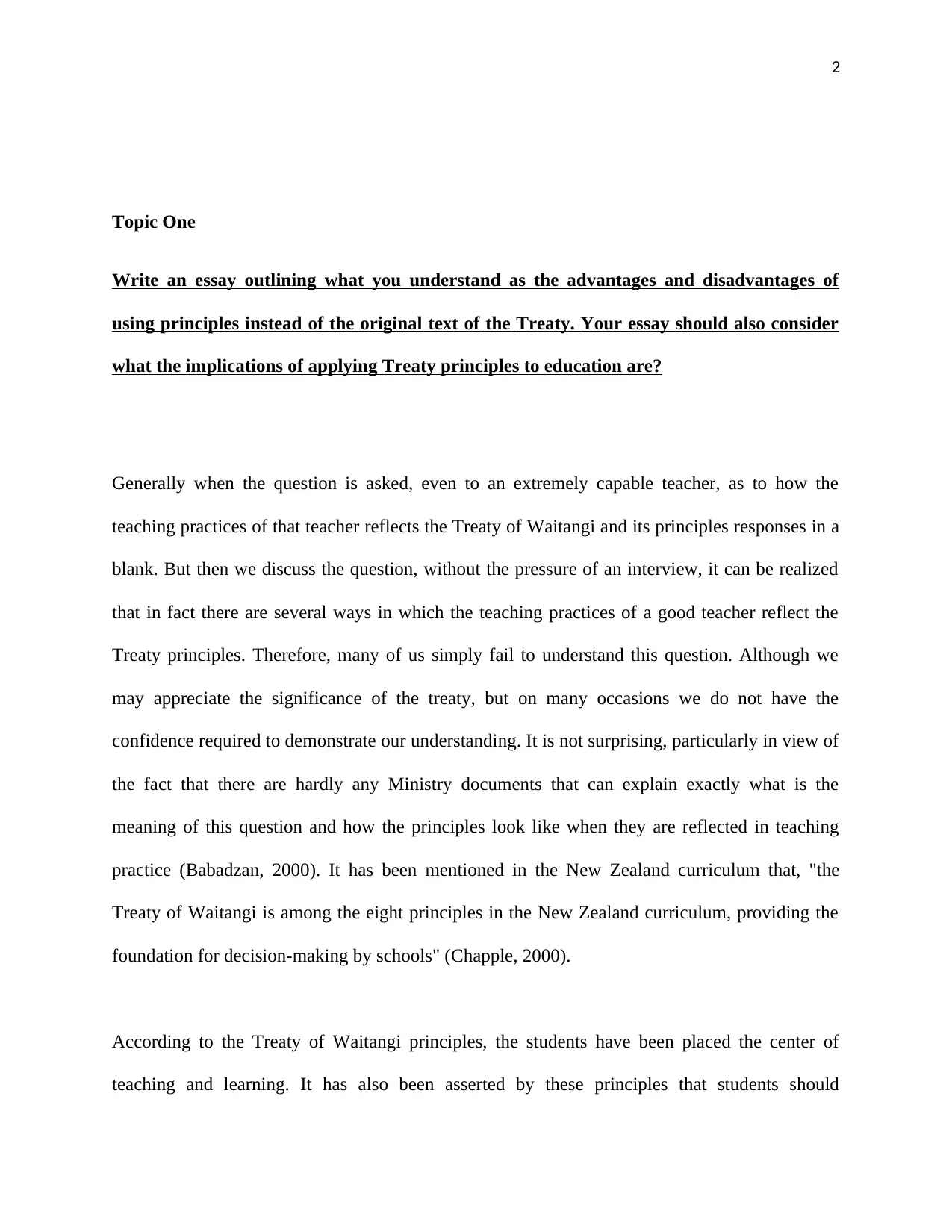
2
Topic One
Write an essay outlining what you understand as the advantages and disadvantages of
using principles instead of the original text of the Treaty. Your essay should also consider
what the implications of applying Treaty principles to education are?
Generally when the question is asked, even to an extremely capable teacher, as to how the
teaching practices of that teacher reflects the Treaty of Waitangi and its principles responses in a
blank. But then we discuss the question, without the pressure of an interview, it can be realized
that in fact there are several ways in which the teaching practices of a good teacher reflect the
Treaty principles. Therefore, many of us simply fail to understand this question. Although we
may appreciate the significance of the treaty, but on many occasions we do not have the
confidence required to demonstrate our understanding. It is not surprising, particularly in view of
the fact that there are hardly any Ministry documents that can explain exactly what is the
meaning of this question and how the principles look like when they are reflected in teaching
practice (Babadzan, 2000). It has been mentioned in the New Zealand curriculum that, "the
Treaty of Waitangi is among the eight principles in the New Zealand curriculum, providing the
foundation for decision-making by schools" (Chapple, 2000).
According to the Treaty of Waitangi principles, the students have been placed the center of
teaching and learning. It has also been asserted by these principles that students should
Topic One
Write an essay outlining what you understand as the advantages and disadvantages of
using principles instead of the original text of the Treaty. Your essay should also consider
what the implications of applying Treaty principles to education are?
Generally when the question is asked, even to an extremely capable teacher, as to how the
teaching practices of that teacher reflects the Treaty of Waitangi and its principles responses in a
blank. But then we discuss the question, without the pressure of an interview, it can be realized
that in fact there are several ways in which the teaching practices of a good teacher reflect the
Treaty principles. Therefore, many of us simply fail to understand this question. Although we
may appreciate the significance of the treaty, but on many occasions we do not have the
confidence required to demonstrate our understanding. It is not surprising, particularly in view of
the fact that there are hardly any Ministry documents that can explain exactly what is the
meaning of this question and how the principles look like when they are reflected in teaching
practice (Babadzan, 2000). It has been mentioned in the New Zealand curriculum that, "the
Treaty of Waitangi is among the eight principles in the New Zealand curriculum, providing the
foundation for decision-making by schools" (Chapple, 2000).
According to the Treaty of Waitangi principles, the students have been placed the center of
teaching and learning. It has also been asserted by these principles that students should
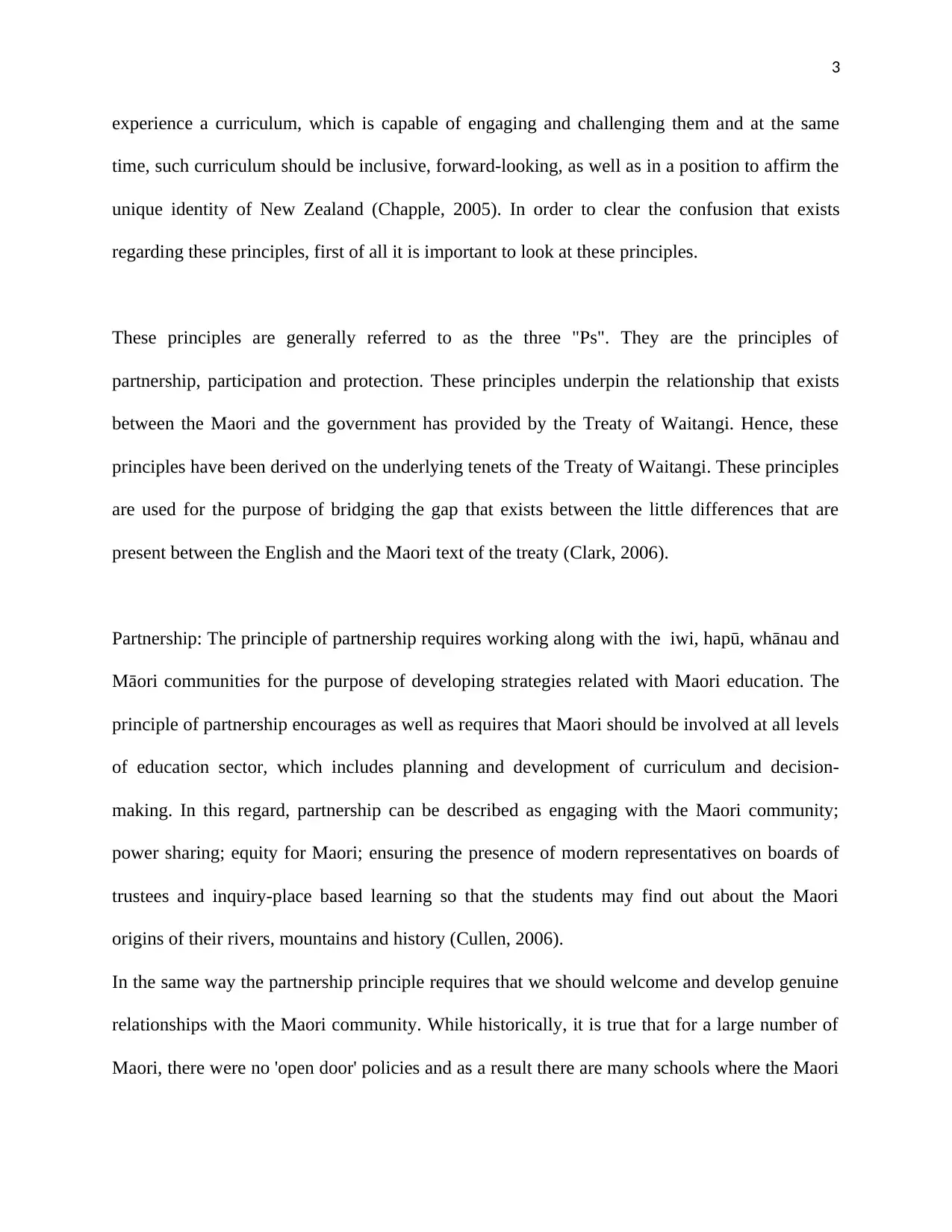
3
experience a curriculum, which is capable of engaging and challenging them and at the same
time, such curriculum should be inclusive, forward-looking, as well as in a position to affirm the
unique identity of New Zealand (Chapple, 2005). In order to clear the confusion that exists
regarding these principles, first of all it is important to look at these principles.
These principles are generally referred to as the three "Ps". They are the principles of
partnership, participation and protection. These principles underpin the relationship that exists
between the Maori and the government has provided by the Treaty of Waitangi. Hence, these
principles have been derived on the underlying tenets of the Treaty of Waitangi. These principles
are used for the purpose of bridging the gap that exists between the little differences that are
present between the English and the Maori text of the treaty (Clark, 2006).
Partnership: The principle of partnership requires working along with the iwi, hapū, whānau and
Māori communities for the purpose of developing strategies related with Maori education. The
principle of partnership encourages as well as requires that Maori should be involved at all levels
of education sector, which includes planning and development of curriculum and decision-
making. In this regard, partnership can be described as engaging with the Maori community;
power sharing; equity for Maori; ensuring the presence of modern representatives on boards of
trustees and inquiry-place based learning so that the students may find out about the Maori
origins of their rivers, mountains and history (Cullen, 2006).
In the same way the partnership principle requires that we should welcome and develop genuine
relationships with the Maori community. While historically, it is true that for a large number of
Maori, there were no 'open door' policies and as a result there are many schools where the Maori
experience a curriculum, which is capable of engaging and challenging them and at the same
time, such curriculum should be inclusive, forward-looking, as well as in a position to affirm the
unique identity of New Zealand (Chapple, 2005). In order to clear the confusion that exists
regarding these principles, first of all it is important to look at these principles.
These principles are generally referred to as the three "Ps". They are the principles of
partnership, participation and protection. These principles underpin the relationship that exists
between the Maori and the government has provided by the Treaty of Waitangi. Hence, these
principles have been derived on the underlying tenets of the Treaty of Waitangi. These principles
are used for the purpose of bridging the gap that exists between the little differences that are
present between the English and the Maori text of the treaty (Clark, 2006).
Partnership: The principle of partnership requires working along with the iwi, hapū, whānau and
Māori communities for the purpose of developing strategies related with Maori education. The
principle of partnership encourages as well as requires that Maori should be involved at all levels
of education sector, which includes planning and development of curriculum and decision-
making. In this regard, partnership can be described as engaging with the Maori community;
power sharing; equity for Maori; ensuring the presence of modern representatives on boards of
trustees and inquiry-place based learning so that the students may find out about the Maori
origins of their rivers, mountains and history (Cullen, 2006).
In the same way the partnership principle requires that we should welcome and develop genuine
relationships with the Maori community. While historically, it is true that for a large number of
Maori, there were no 'open door' policies and as a result there are many schools where the Maori
⊘ This is a preview!⊘
Do you want full access?
Subscribe today to unlock all pages.

Trusted by 1+ million students worldwide
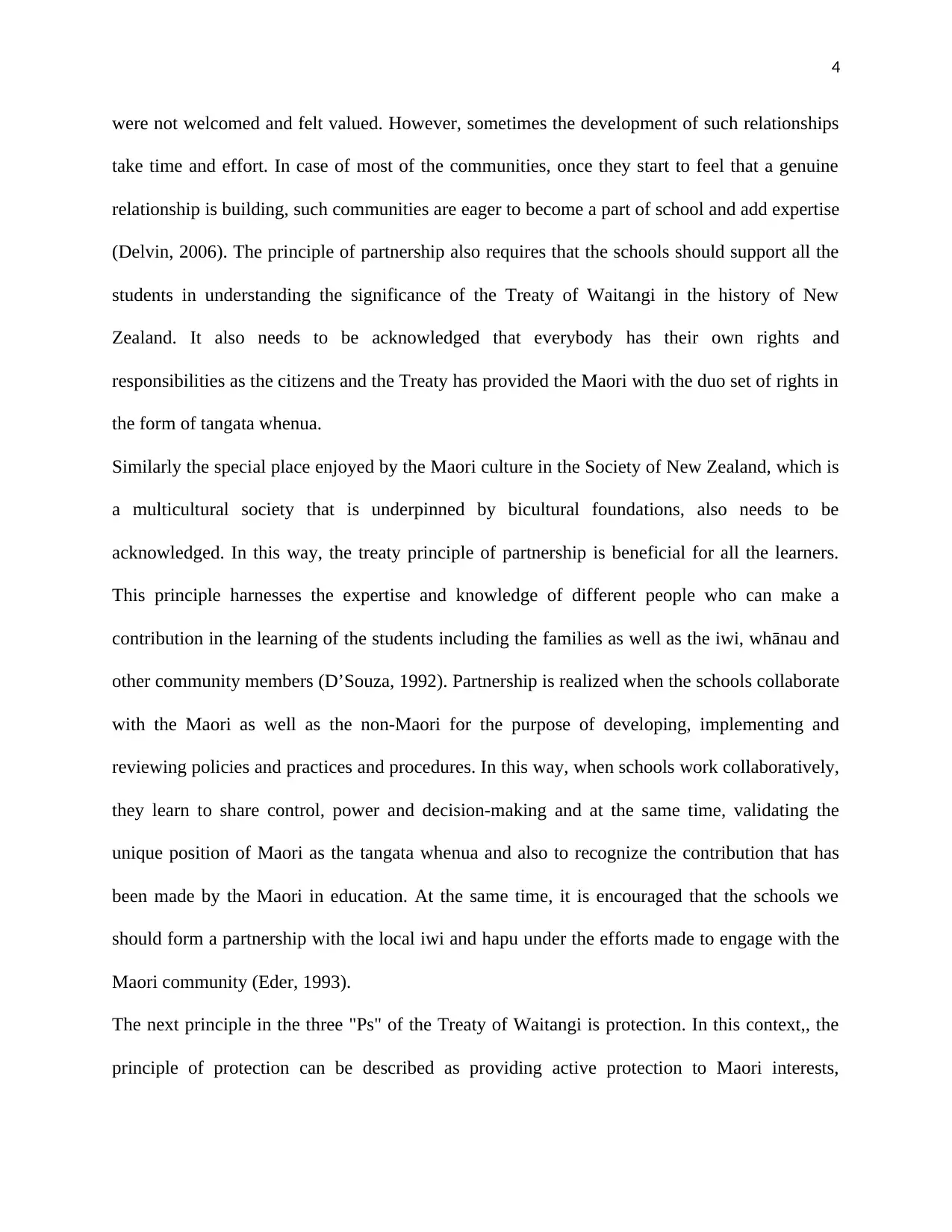
4
were not welcomed and felt valued. However, sometimes the development of such relationships
take time and effort. In case of most of the communities, once they start to feel that a genuine
relationship is building, such communities are eager to become a part of school and add expertise
(Delvin, 2006). The principle of partnership also requires that the schools should support all the
students in understanding the significance of the Treaty of Waitangi in the history of New
Zealand. It also needs to be acknowledged that everybody has their own rights and
responsibilities as the citizens and the Treaty has provided the Maori with the duo set of rights in
the form of tangata whenua.
Similarly the special place enjoyed by the Maori culture in the Society of New Zealand, which is
a multicultural society that is underpinned by bicultural foundations, also needs to be
acknowledged. In this way, the treaty principle of partnership is beneficial for all the learners.
This principle harnesses the expertise and knowledge of different people who can make a
contribution in the learning of the students including the families as well as the iwi, whānau and
other community members (D’Souza, 1992). Partnership is realized when the schools collaborate
with the Maori as well as the non-Maori for the purpose of developing, implementing and
reviewing policies and practices and procedures. In this way, when schools work collaboratively,
they learn to share control, power and decision-making and at the same time, validating the
unique position of Maori as the tangata whenua and also to recognize the contribution that has
been made by the Maori in education. At the same time, it is encouraged that the schools we
should form a partnership with the local iwi and hapu under the efforts made to engage with the
Maori community (Eder, 1993).
The next principle in the three "Ps" of the Treaty of Waitangi is protection. In this context,, the
principle of protection can be described as providing active protection to Maori interests,
were not welcomed and felt valued. However, sometimes the development of such relationships
take time and effort. In case of most of the communities, once they start to feel that a genuine
relationship is building, such communities are eager to become a part of school and add expertise
(Delvin, 2006). The principle of partnership also requires that the schools should support all the
students in understanding the significance of the Treaty of Waitangi in the history of New
Zealand. It also needs to be acknowledged that everybody has their own rights and
responsibilities as the citizens and the Treaty has provided the Maori with the duo set of rights in
the form of tangata whenua.
Similarly the special place enjoyed by the Maori culture in the Society of New Zealand, which is
a multicultural society that is underpinned by bicultural foundations, also needs to be
acknowledged. In this way, the treaty principle of partnership is beneficial for all the learners.
This principle harnesses the expertise and knowledge of different people who can make a
contribution in the learning of the students including the families as well as the iwi, whānau and
other community members (D’Souza, 1992). Partnership is realized when the schools collaborate
with the Maori as well as the non-Maori for the purpose of developing, implementing and
reviewing policies and practices and procedures. In this way, when schools work collaboratively,
they learn to share control, power and decision-making and at the same time, validating the
unique position of Maori as the tangata whenua and also to recognize the contribution that has
been made by the Maori in education. At the same time, it is encouraged that the schools we
should form a partnership with the local iwi and hapu under the efforts made to engage with the
Maori community (Eder, 1993).
The next principle in the three "Ps" of the Treaty of Waitangi is protection. In this context,, the
principle of protection can be described as providing active protection to Maori interests,
Paraphrase This Document
Need a fresh take? Get an instant paraphrase of this document with our AI Paraphraser
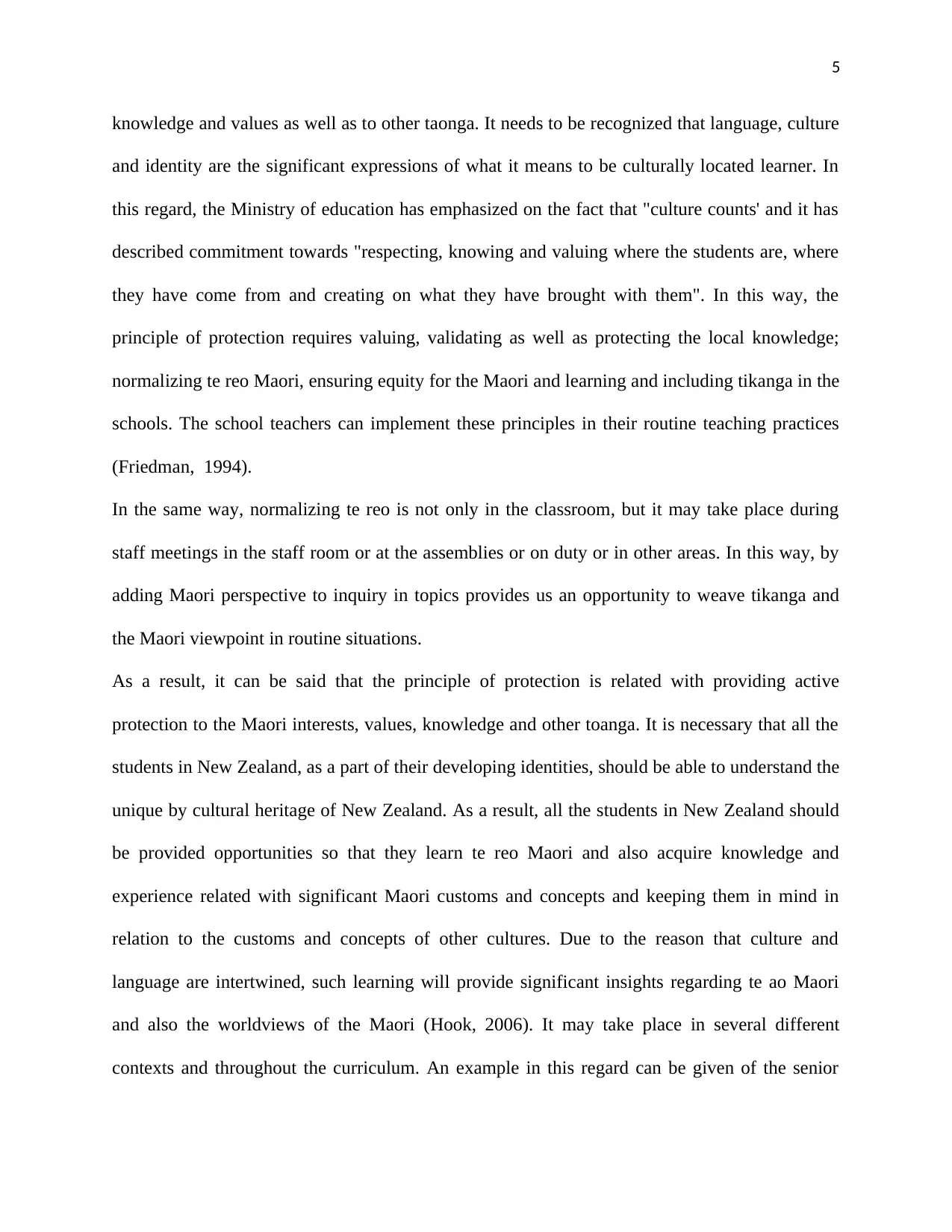
5
knowledge and values as well as to other taonga. It needs to be recognized that language, culture
and identity are the significant expressions of what it means to be culturally located learner. In
this regard, the Ministry of education has emphasized on the fact that "culture counts' and it has
described commitment towards "respecting, knowing and valuing where the students are, where
they have come from and creating on what they have brought with them". In this way, the
principle of protection requires valuing, validating as well as protecting the local knowledge;
normalizing te reo Maori, ensuring equity for the Maori and learning and including tikanga in the
schools. The school teachers can implement these principles in their routine teaching practices
(Friedman, 1994).
In the same way, normalizing te reo is not only in the classroom, but it may take place during
staff meetings in the staff room or at the assemblies or on duty or in other areas. In this way, by
adding Maori perspective to inquiry in topics provides us an opportunity to weave tikanga and
the Maori viewpoint in routine situations.
As a result, it can be said that the principle of protection is related with providing active
protection to the Maori interests, values, knowledge and other toanga. It is necessary that all the
students in New Zealand, as a part of their developing identities, should be able to understand the
unique by cultural heritage of New Zealand. As a result, all the students in New Zealand should
be provided opportunities so that they learn te reo Maori and also acquire knowledge and
experience related with significant Maori customs and concepts and keeping them in mind in
relation to the customs and concepts of other cultures. Due to the reason that culture and
language are intertwined, such learning will provide significant insights regarding te ao Maori
and also the worldviews of the Maori (Hook, 2006). It may take place in several different
contexts and throughout the curriculum. An example in this regard can be given of the senior
knowledge and values as well as to other taonga. It needs to be recognized that language, culture
and identity are the significant expressions of what it means to be culturally located learner. In
this regard, the Ministry of education has emphasized on the fact that "culture counts' and it has
described commitment towards "respecting, knowing and valuing where the students are, where
they have come from and creating on what they have brought with them". In this way, the
principle of protection requires valuing, validating as well as protecting the local knowledge;
normalizing te reo Maori, ensuring equity for the Maori and learning and including tikanga in the
schools. The school teachers can implement these principles in their routine teaching practices
(Friedman, 1994).
In the same way, normalizing te reo is not only in the classroom, but it may take place during
staff meetings in the staff room or at the assemblies or on duty or in other areas. In this way, by
adding Maori perspective to inquiry in topics provides us an opportunity to weave tikanga and
the Maori viewpoint in routine situations.
As a result, it can be said that the principle of protection is related with providing active
protection to the Maori interests, values, knowledge and other toanga. It is necessary that all the
students in New Zealand, as a part of their developing identities, should be able to understand the
unique by cultural heritage of New Zealand. As a result, all the students in New Zealand should
be provided opportunities so that they learn te reo Maori and also acquire knowledge and
experience related with significant Maori customs and concepts and keeping them in mind in
relation to the customs and concepts of other cultures. Due to the reason that culture and
language are intertwined, such learning will provide significant insights regarding te ao Maori
and also the worldviews of the Maori (Hook, 2006). It may take place in several different
contexts and throughout the curriculum. An example in this regard can be given of the senior
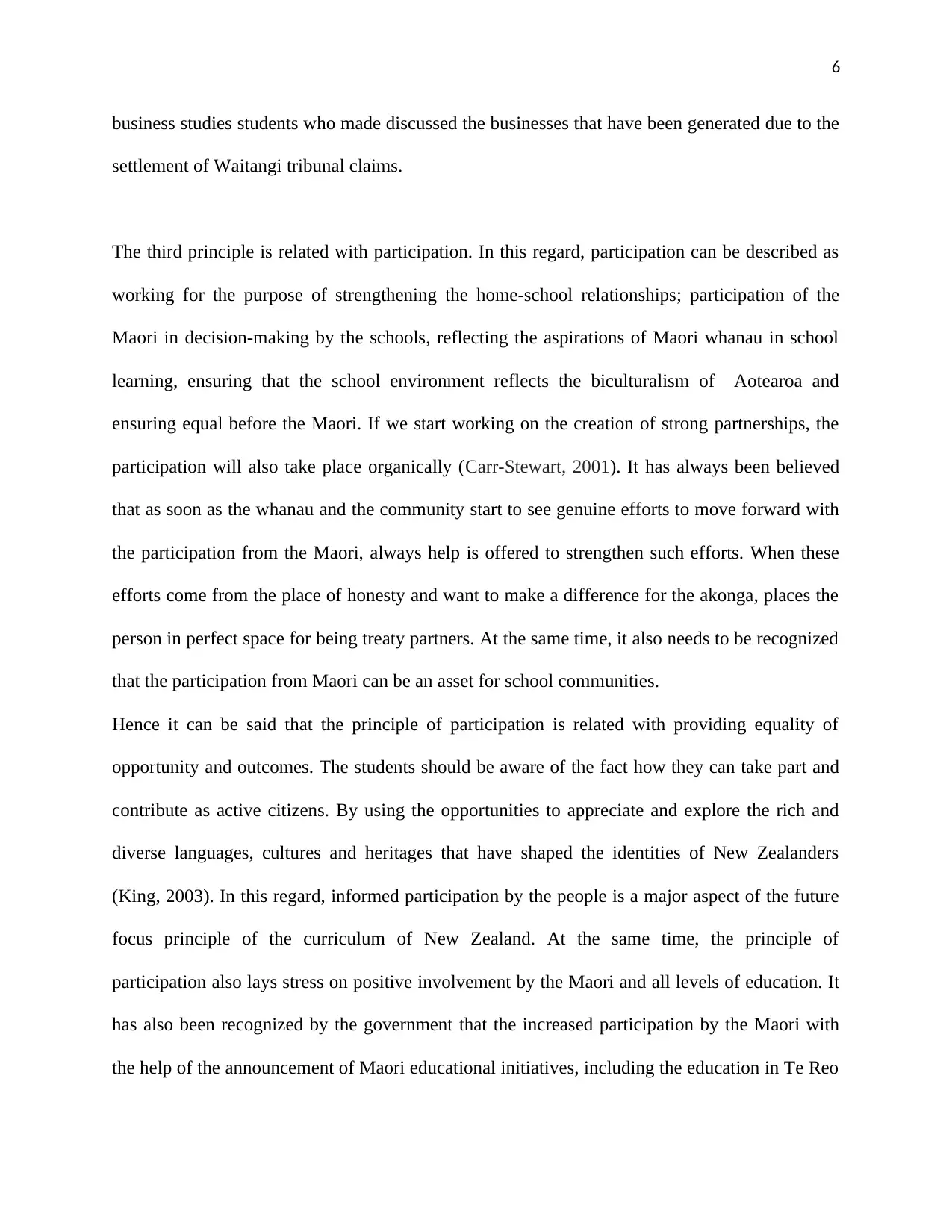
6
business studies students who made discussed the businesses that have been generated due to the
settlement of Waitangi tribunal claims.
The third principle is related with participation. In this regard, participation can be described as
working for the purpose of strengthening the home-school relationships; participation of the
Maori in decision-making by the schools, reflecting the aspirations of Maori whanau in school
learning, ensuring that the school environment reflects the biculturalism of Aotearoa and
ensuring equal before the Maori. If we start working on the creation of strong partnerships, the
participation will also take place organically (Carr-Stewart, 2001). It has always been believed
that as soon as the whanau and the community start to see genuine efforts to move forward with
the participation from the Maori, always help is offered to strengthen such efforts. When these
efforts come from the place of honesty and want to make a difference for the akonga, places the
person in perfect space for being treaty partners. At the same time, it also needs to be recognized
that the participation from Maori can be an asset for school communities.
Hence it can be said that the principle of participation is related with providing equality of
opportunity and outcomes. The students should be aware of the fact how they can take part and
contribute as active citizens. By using the opportunities to appreciate and explore the rich and
diverse languages, cultures and heritages that have shaped the identities of New Zealanders
(King, 2003). In this regard, informed participation by the people is a major aspect of the future
focus principle of the curriculum of New Zealand. At the same time, the principle of
participation also lays stress on positive involvement by the Maori and all levels of education. It
has also been recognized by the government that the increased participation by the Maori with
the help of the announcement of Maori educational initiatives, including the education in Te Reo
business studies students who made discussed the businesses that have been generated due to the
settlement of Waitangi tribunal claims.
The third principle is related with participation. In this regard, participation can be described as
working for the purpose of strengthening the home-school relationships; participation of the
Maori in decision-making by the schools, reflecting the aspirations of Maori whanau in school
learning, ensuring that the school environment reflects the biculturalism of Aotearoa and
ensuring equal before the Maori. If we start working on the creation of strong partnerships, the
participation will also take place organically (Carr-Stewart, 2001). It has always been believed
that as soon as the whanau and the community start to see genuine efforts to move forward with
the participation from the Maori, always help is offered to strengthen such efforts. When these
efforts come from the place of honesty and want to make a difference for the akonga, places the
person in perfect space for being treaty partners. At the same time, it also needs to be recognized
that the participation from Maori can be an asset for school communities.
Hence it can be said that the principle of participation is related with providing equality of
opportunity and outcomes. The students should be aware of the fact how they can take part and
contribute as active citizens. By using the opportunities to appreciate and explore the rich and
diverse languages, cultures and heritages that have shaped the identities of New Zealanders
(King, 2003). In this regard, informed participation by the people is a major aspect of the future
focus principle of the curriculum of New Zealand. At the same time, the principle of
participation also lays stress on positive involvement by the Maori and all levels of education. It
has also been recognized by the government that the increased participation by the Maori with
the help of the announcement of Maori educational initiatives, including the education in Te Reo
⊘ This is a preview!⊘
Do you want full access?
Subscribe today to unlock all pages.

Trusted by 1+ million students worldwide
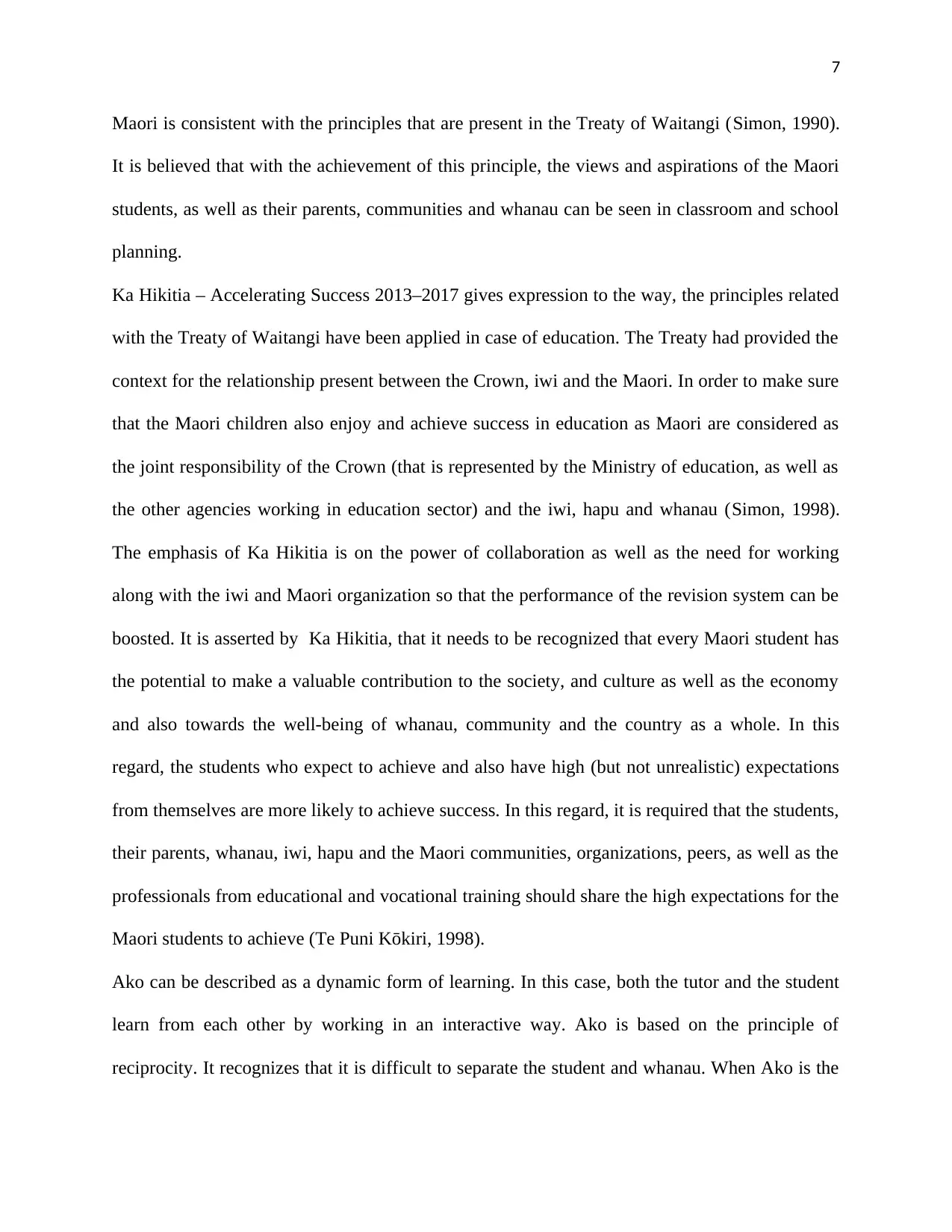
7
Maori is consistent with the principles that are present in the Treaty of Waitangi (Simon, 1990).
It is believed that with the achievement of this principle, the views and aspirations of the Maori
students, as well as their parents, communities and whanau can be seen in classroom and school
planning.
Ka Hikitia – Accelerating Success 2013–2017 gives expression to the way, the principles related
with the Treaty of Waitangi have been applied in case of education. The Treaty had provided the
context for the relationship present between the Crown, iwi and the Maori. In order to make sure
that the Maori children also enjoy and achieve success in education as Maori are considered as
the joint responsibility of the Crown (that is represented by the Ministry of education, as well as
the other agencies working in education sector) and the iwi, hapu and whanau (Simon, 1998).
The emphasis of Ka Hikitia is on the power of collaboration as well as the need for working
along with the iwi and Maori organization so that the performance of the revision system can be
boosted. It is asserted by Ka Hikitia, that it needs to be recognized that every Maori student has
the potential to make a valuable contribution to the society, and culture as well as the economy
and also towards the well-being of whanau, community and the country as a whole. In this
regard, the students who expect to achieve and also have high (but not unrealistic) expectations
from themselves are more likely to achieve success. In this regard, it is required that the students,
their parents, whanau, iwi, hapu and the Maori communities, organizations, peers, as well as the
professionals from educational and vocational training should share the high expectations for the
Maori students to achieve (Te Puni Kōkiri, 1998).
Ako can be described as a dynamic form of learning. In this case, both the tutor and the student
learn from each other by working in an interactive way. Ako is based on the principle of
reciprocity. It recognizes that it is difficult to separate the student and whanau. When Ako is the
Maori is consistent with the principles that are present in the Treaty of Waitangi (Simon, 1990).
It is believed that with the achievement of this principle, the views and aspirations of the Maori
students, as well as their parents, communities and whanau can be seen in classroom and school
planning.
Ka Hikitia – Accelerating Success 2013–2017 gives expression to the way, the principles related
with the Treaty of Waitangi have been applied in case of education. The Treaty had provided the
context for the relationship present between the Crown, iwi and the Maori. In order to make sure
that the Maori children also enjoy and achieve success in education as Maori are considered as
the joint responsibility of the Crown (that is represented by the Ministry of education, as well as
the other agencies working in education sector) and the iwi, hapu and whanau (Simon, 1998).
The emphasis of Ka Hikitia is on the power of collaboration as well as the need for working
along with the iwi and Maori organization so that the performance of the revision system can be
boosted. It is asserted by Ka Hikitia, that it needs to be recognized that every Maori student has
the potential to make a valuable contribution to the society, and culture as well as the economy
and also towards the well-being of whanau, community and the country as a whole. In this
regard, the students who expect to achieve and also have high (but not unrealistic) expectations
from themselves are more likely to achieve success. In this regard, it is required that the students,
their parents, whanau, iwi, hapu and the Maori communities, organizations, peers, as well as the
professionals from educational and vocational training should share the high expectations for the
Maori students to achieve (Te Puni Kōkiri, 1998).
Ako can be described as a dynamic form of learning. In this case, both the tutor and the student
learn from each other by working in an interactive way. Ako is based on the principle of
reciprocity. It recognizes that it is difficult to separate the student and whanau. When Ako is the
Paraphrase This Document
Need a fresh take? Get an instant paraphrase of this document with our AI Paraphraser
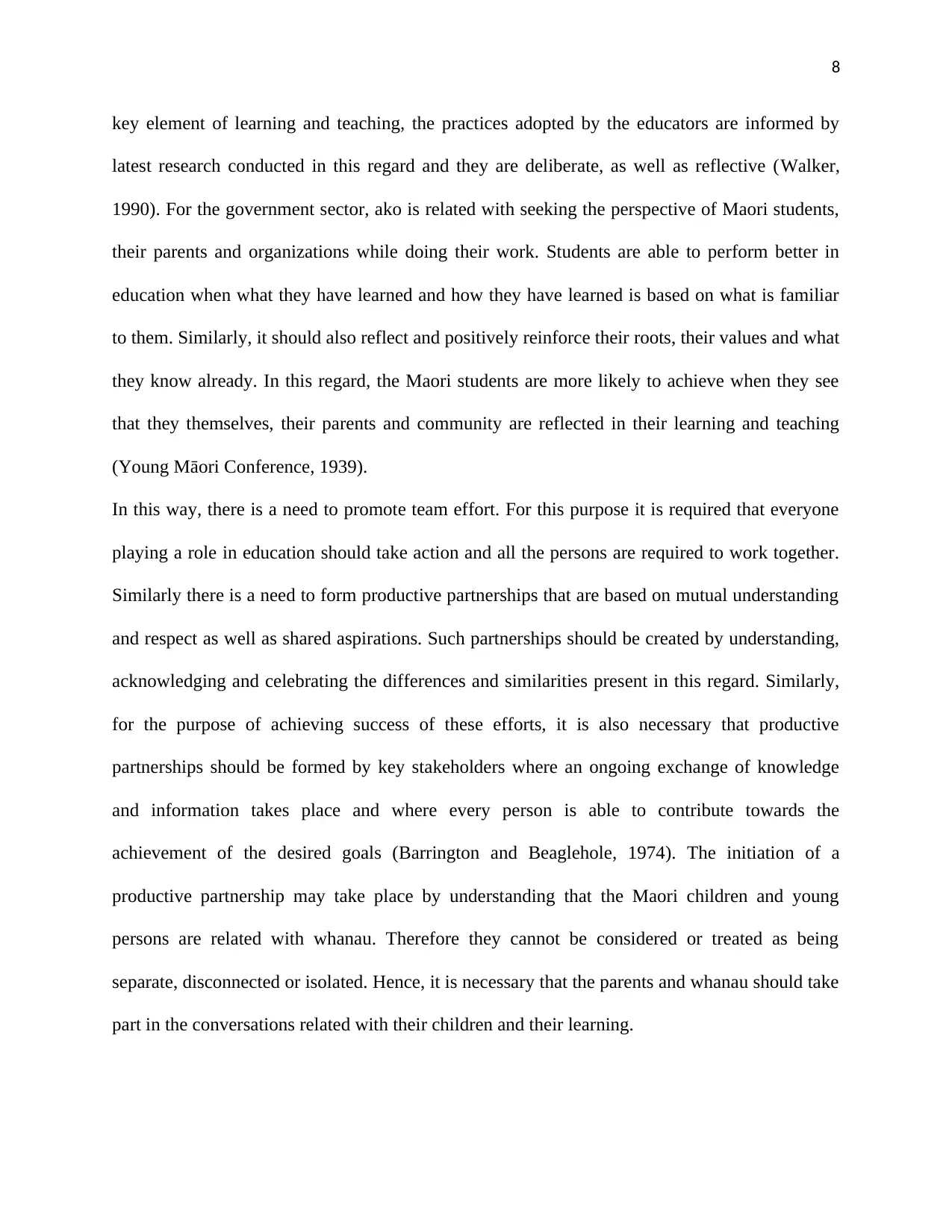
8
key element of learning and teaching, the practices adopted by the educators are informed by
latest research conducted in this regard and they are deliberate, as well as reflective (Walker,
1990). For the government sector, ako is related with seeking the perspective of Maori students,
their parents and organizations while doing their work. Students are able to perform better in
education when what they have learned and how they have learned is based on what is familiar
to them. Similarly, it should also reflect and positively reinforce their roots, their values and what
they know already. In this regard, the Maori students are more likely to achieve when they see
that they themselves, their parents and community are reflected in their learning and teaching
(Young Māori Conference, 1939).
In this way, there is a need to promote team effort. For this purpose it is required that everyone
playing a role in education should take action and all the persons are required to work together.
Similarly there is a need to form productive partnerships that are based on mutual understanding
and respect as well as shared aspirations. Such partnerships should be created by understanding,
acknowledging and celebrating the differences and similarities present in this regard. Similarly,
for the purpose of achieving success of these efforts, it is also necessary that productive
partnerships should be formed by key stakeholders where an ongoing exchange of knowledge
and information takes place and where every person is able to contribute towards the
achievement of the desired goals (Barrington and Beaglehole, 1974). The initiation of a
productive partnership may take place by understanding that the Maori children and young
persons are related with whanau. Therefore they cannot be considered or treated as being
separate, disconnected or isolated. Hence, it is necessary that the parents and whanau should take
part in the conversations related with their children and their learning.
key element of learning and teaching, the practices adopted by the educators are informed by
latest research conducted in this regard and they are deliberate, as well as reflective (Walker,
1990). For the government sector, ako is related with seeking the perspective of Maori students,
their parents and organizations while doing their work. Students are able to perform better in
education when what they have learned and how they have learned is based on what is familiar
to them. Similarly, it should also reflect and positively reinforce their roots, their values and what
they know already. In this regard, the Maori students are more likely to achieve when they see
that they themselves, their parents and community are reflected in their learning and teaching
(Young Māori Conference, 1939).
In this way, there is a need to promote team effort. For this purpose it is required that everyone
playing a role in education should take action and all the persons are required to work together.
Similarly there is a need to form productive partnerships that are based on mutual understanding
and respect as well as shared aspirations. Such partnerships should be created by understanding,
acknowledging and celebrating the differences and similarities present in this regard. Similarly,
for the purpose of achieving success of these efforts, it is also necessary that productive
partnerships should be formed by key stakeholders where an ongoing exchange of knowledge
and information takes place and where every person is able to contribute towards the
achievement of the desired goals (Barrington and Beaglehole, 1974). The initiation of a
productive partnership may take place by understanding that the Maori children and young
persons are related with whanau. Therefore they cannot be considered or treated as being
separate, disconnected or isolated. Hence, it is necessary that the parents and whanau should take
part in the conversations related with their children and their learning.
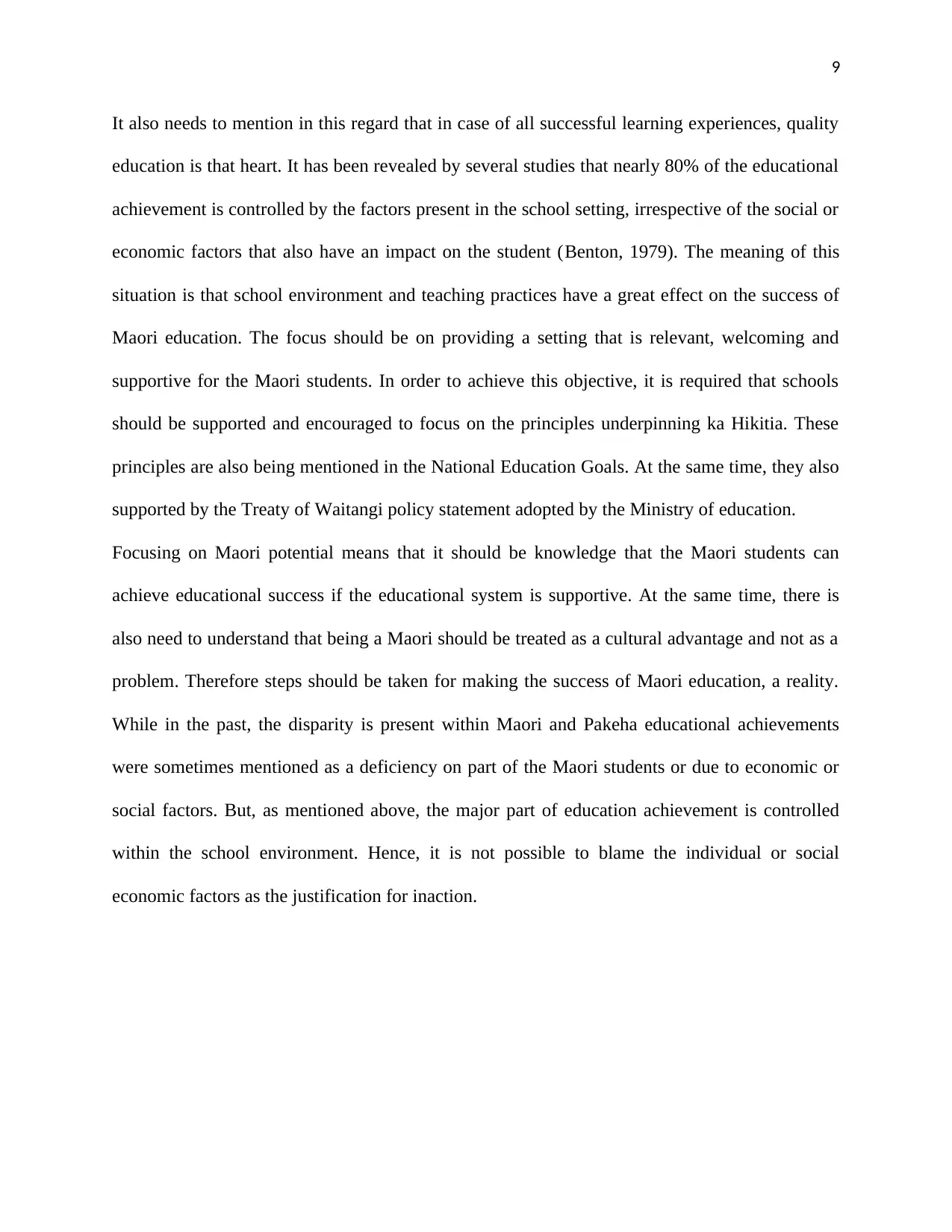
9
It also needs to mention in this regard that in case of all successful learning experiences, quality
education is that heart. It has been revealed by several studies that nearly 80% of the educational
achievement is controlled by the factors present in the school setting, irrespective of the social or
economic factors that also have an impact on the student (Benton, 1979). The meaning of this
situation is that school environment and teaching practices have a great effect on the success of
Maori education. The focus should be on providing a setting that is relevant, welcoming and
supportive for the Maori students. In order to achieve this objective, it is required that schools
should be supported and encouraged to focus on the principles underpinning ka Hikitia. These
principles are also being mentioned in the National Education Goals. At the same time, they also
supported by the Treaty of Waitangi policy statement adopted by the Ministry of education.
Focusing on Maori potential means that it should be knowledge that the Maori students can
achieve educational success if the educational system is supportive. At the same time, there is
also need to understand that being a Maori should be treated as a cultural advantage and not as a
problem. Therefore steps should be taken for making the success of Maori education, a reality.
While in the past, the disparity is present within Maori and Pakeha educational achievements
were sometimes mentioned as a deficiency on part of the Maori students or due to economic or
social factors. But, as mentioned above, the major part of education achievement is controlled
within the school environment. Hence, it is not possible to blame the individual or social
economic factors as the justification for inaction.
It also needs to mention in this regard that in case of all successful learning experiences, quality
education is that heart. It has been revealed by several studies that nearly 80% of the educational
achievement is controlled by the factors present in the school setting, irrespective of the social or
economic factors that also have an impact on the student (Benton, 1979). The meaning of this
situation is that school environment and teaching practices have a great effect on the success of
Maori education. The focus should be on providing a setting that is relevant, welcoming and
supportive for the Maori students. In order to achieve this objective, it is required that schools
should be supported and encouraged to focus on the principles underpinning ka Hikitia. These
principles are also being mentioned in the National Education Goals. At the same time, they also
supported by the Treaty of Waitangi policy statement adopted by the Ministry of education.
Focusing on Maori potential means that it should be knowledge that the Maori students can
achieve educational success if the educational system is supportive. At the same time, there is
also need to understand that being a Maori should be treated as a cultural advantage and not as a
problem. Therefore steps should be taken for making the success of Maori education, a reality.
While in the past, the disparity is present within Maori and Pakeha educational achievements
were sometimes mentioned as a deficiency on part of the Maori students or due to economic or
social factors. But, as mentioned above, the major part of education achievement is controlled
within the school environment. Hence, it is not possible to blame the individual or social
economic factors as the justification for inaction.
⊘ This is a preview!⊘
Do you want full access?
Subscribe today to unlock all pages.

Trusted by 1+ million students worldwide
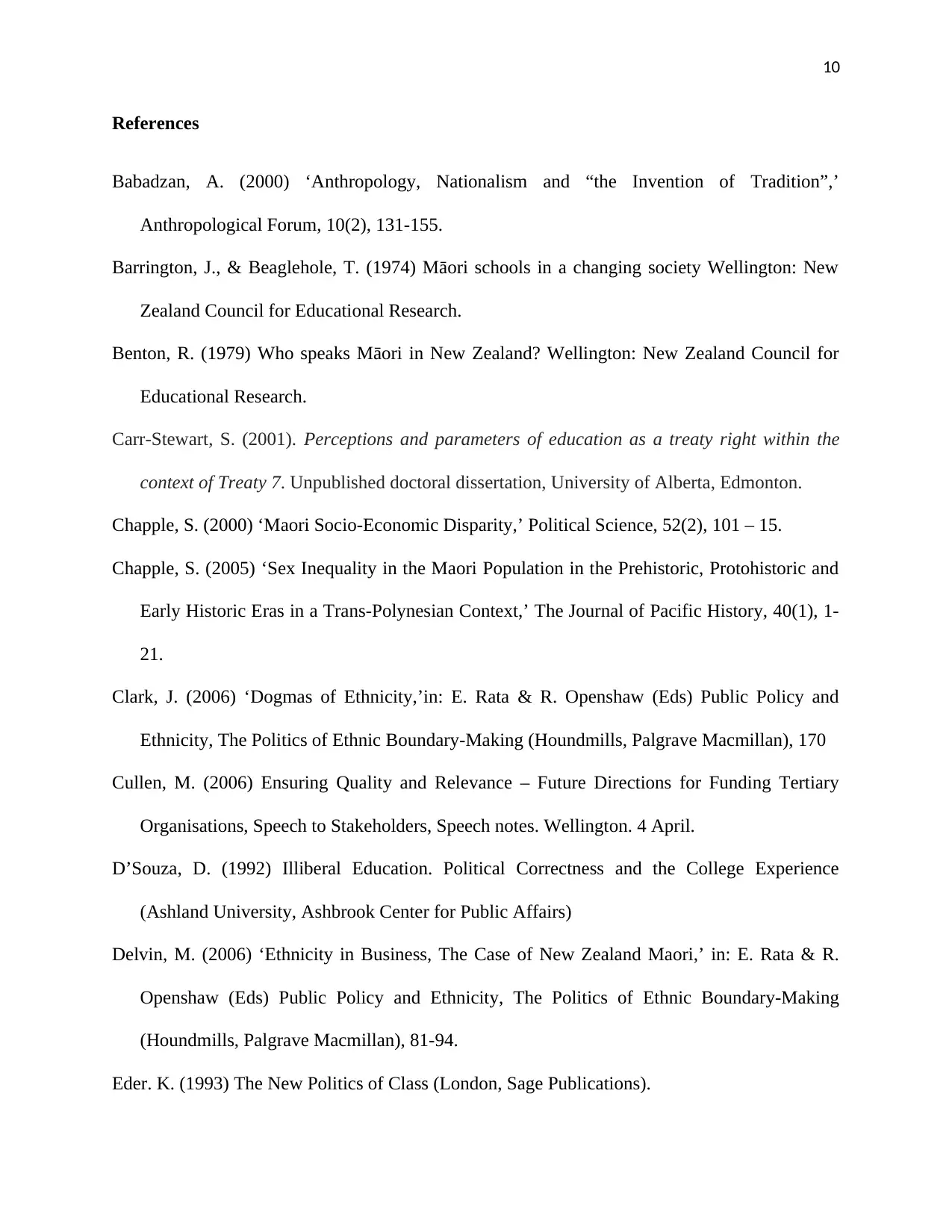
10
References
Babadzan, A. (2000) ‘Anthropology, Nationalism and “the Invention of Tradition”,’
Anthropological Forum, 10(2), 131-155.
Barrington, J., & Beaglehole, T. (1974) Māori schools in a changing society Wellington: New
Zealand Council for Educational Research.
Benton, R. (1979) Who speaks Māori in New Zealand? Wellington: New Zealand Council for
Educational Research.
Carr-Stewart, S. (2001). Perceptions and parameters of education as a treaty right within the
context of Treaty 7. Unpublished doctoral dissertation, University of Alberta, Edmonton.
Chapple, S. (2000) ‘Maori Socio-Economic Disparity,’ Political Science, 52(2), 101 – 15.
Chapple, S. (2005) ‘Sex Inequality in the Maori Population in the Prehistoric, Protohistoric and
Early Historic Eras in a Trans-Polynesian Context,’ The Journal of Pacific History, 40(1), 1-
21.
Clark, J. (2006) ‘Dogmas of Ethnicity,’in: E. Rata & R. Openshaw (Eds) Public Policy and
Ethnicity, The Politics of Ethnic Boundary-Making (Houndmills, Palgrave Macmillan), 170
Cullen, M. (2006) Ensuring Quality and Relevance – Future Directions for Funding Tertiary
Organisations, Speech to Stakeholders, Speech notes. Wellington. 4 April.
D’Souza, D. (1992) Illiberal Education. Political Correctness and the College Experience
(Ashland University, Ashbrook Center for Public Affairs)
Delvin, M. (2006) ‘Ethnicity in Business, The Case of New Zealand Maori,’ in: E. Rata & R.
Openshaw (Eds) Public Policy and Ethnicity, The Politics of Ethnic Boundary-Making
(Houndmills, Palgrave Macmillan), 81-94.
Eder. K. (1993) The New Politics of Class (London, Sage Publications).
References
Babadzan, A. (2000) ‘Anthropology, Nationalism and “the Invention of Tradition”,’
Anthropological Forum, 10(2), 131-155.
Barrington, J., & Beaglehole, T. (1974) Māori schools in a changing society Wellington: New
Zealand Council for Educational Research.
Benton, R. (1979) Who speaks Māori in New Zealand? Wellington: New Zealand Council for
Educational Research.
Carr-Stewart, S. (2001). Perceptions and parameters of education as a treaty right within the
context of Treaty 7. Unpublished doctoral dissertation, University of Alberta, Edmonton.
Chapple, S. (2000) ‘Maori Socio-Economic Disparity,’ Political Science, 52(2), 101 – 15.
Chapple, S. (2005) ‘Sex Inequality in the Maori Population in the Prehistoric, Protohistoric and
Early Historic Eras in a Trans-Polynesian Context,’ The Journal of Pacific History, 40(1), 1-
21.
Clark, J. (2006) ‘Dogmas of Ethnicity,’in: E. Rata & R. Openshaw (Eds) Public Policy and
Ethnicity, The Politics of Ethnic Boundary-Making (Houndmills, Palgrave Macmillan), 170
Cullen, M. (2006) Ensuring Quality and Relevance – Future Directions for Funding Tertiary
Organisations, Speech to Stakeholders, Speech notes. Wellington. 4 April.
D’Souza, D. (1992) Illiberal Education. Political Correctness and the College Experience
(Ashland University, Ashbrook Center for Public Affairs)
Delvin, M. (2006) ‘Ethnicity in Business, The Case of New Zealand Maori,’ in: E. Rata & R.
Openshaw (Eds) Public Policy and Ethnicity, The Politics of Ethnic Boundary-Making
(Houndmills, Palgrave Macmillan), 81-94.
Eder. K. (1993) The New Politics of Class (London, Sage Publications).
Paraphrase This Document
Need a fresh take? Get an instant paraphrase of this document with our AI Paraphraser
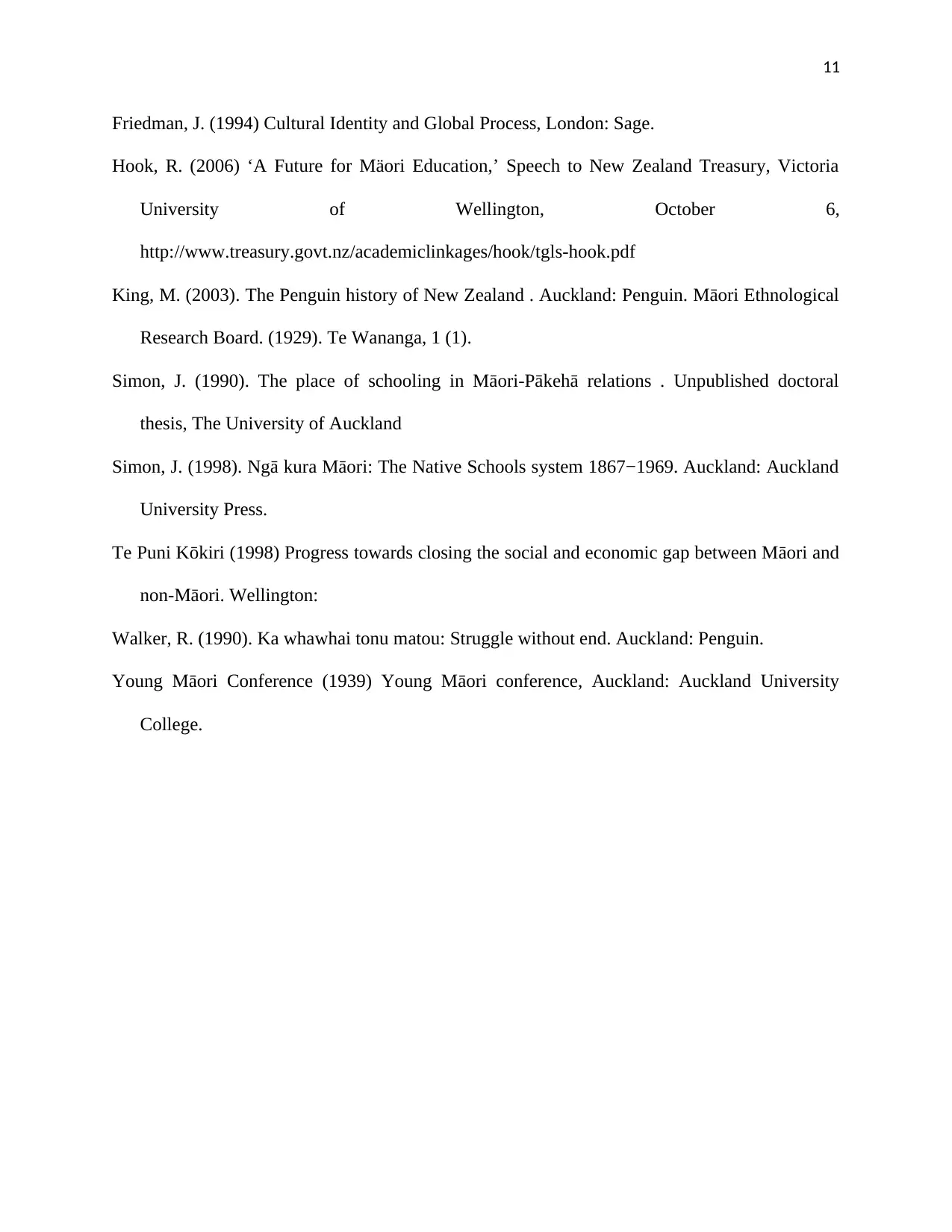
11
Friedman, J. (1994) Cultural Identity and Global Process, London: Sage.
Hook, R. (2006) ‘A Future for Mäori Education,’ Speech to New Zealand Treasury, Victoria
University of Wellington, October 6,
http://www.treasury.govt.nz/academiclinkages/hook/tgls-hook.pdf
King, M. (2003). The Penguin history of New Zealand . Auckland: Penguin. Māori Ethnological
Research Board. (1929). Te Wananga, 1 (1).
Simon, J. (1990). The place of schooling in Māori-Pākehā relations . Unpublished doctoral
thesis, The University of Auckland
Simon, J. (1998). Ngā kura Māori: The Native Schools system 1867−1969. Auckland: Auckland
University Press.
Te Puni Kōkiri (1998) Progress towards closing the social and economic gap between Māori and
non-Māori. Wellington:
Walker, R. (1990). Ka whawhai tonu matou: Struggle without end. Auckland: Penguin.
Young Māori Conference (1939) Young Māori conference, Auckland: Auckland University
College.
Friedman, J. (1994) Cultural Identity and Global Process, London: Sage.
Hook, R. (2006) ‘A Future for Mäori Education,’ Speech to New Zealand Treasury, Victoria
University of Wellington, October 6,
http://www.treasury.govt.nz/academiclinkages/hook/tgls-hook.pdf
King, M. (2003). The Penguin history of New Zealand . Auckland: Penguin. Māori Ethnological
Research Board. (1929). Te Wananga, 1 (1).
Simon, J. (1990). The place of schooling in Māori-Pākehā relations . Unpublished doctoral
thesis, The University of Auckland
Simon, J. (1998). Ngā kura Māori: The Native Schools system 1867−1969. Auckland: Auckland
University Press.
Te Puni Kōkiri (1998) Progress towards closing the social and economic gap between Māori and
non-Māori. Wellington:
Walker, R. (1990). Ka whawhai tonu matou: Struggle without end. Auckland: Penguin.
Young Māori Conference (1939) Young Māori conference, Auckland: Auckland University
College.
1 out of 11
Related Documents
Your All-in-One AI-Powered Toolkit for Academic Success.
+13062052269
info@desklib.com
Available 24*7 on WhatsApp / Email
![[object Object]](/_next/static/media/star-bottom.7253800d.svg)
Unlock your academic potential
Copyright © 2020–2025 A2Z Services. All Rights Reserved. Developed and managed by ZUCOL.





